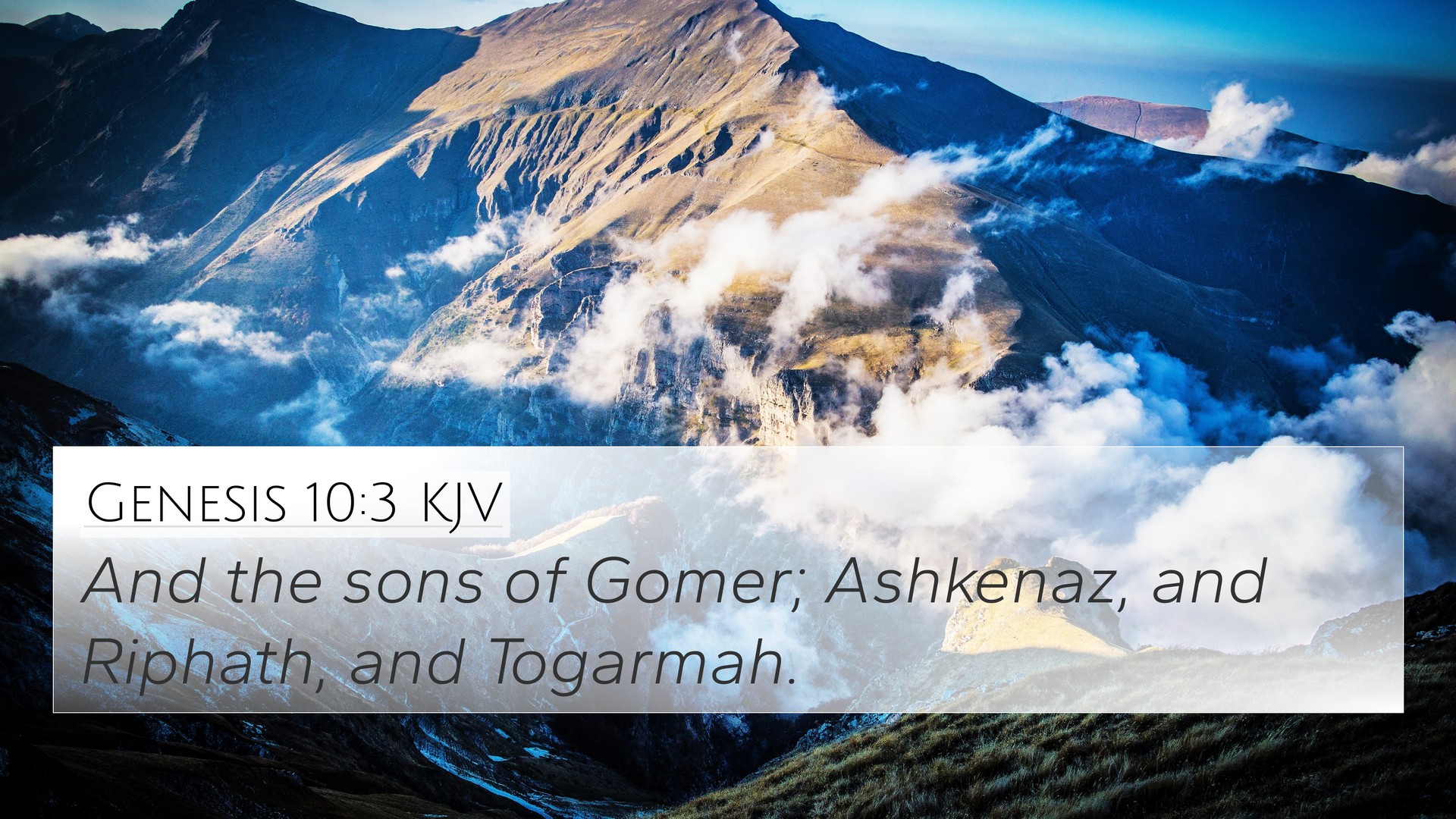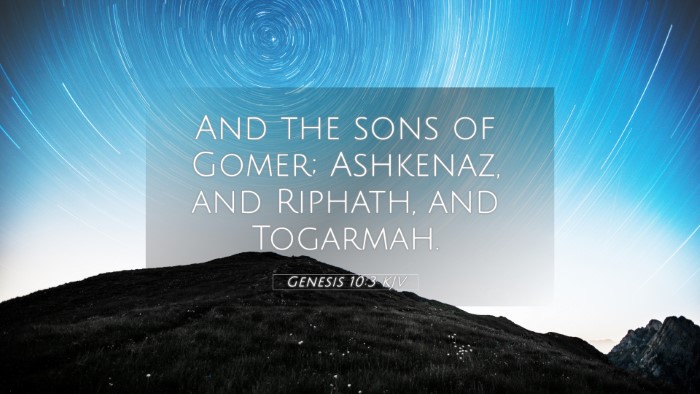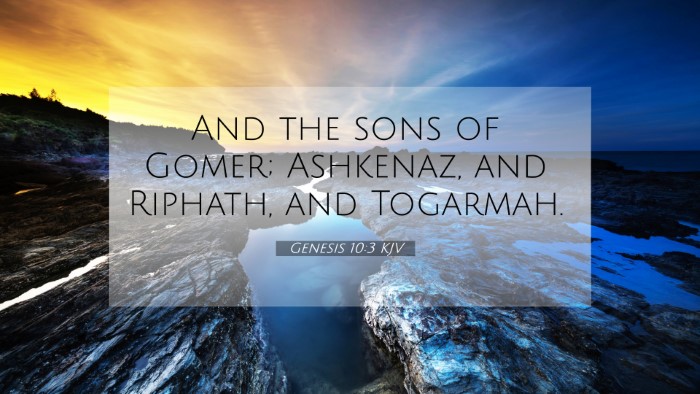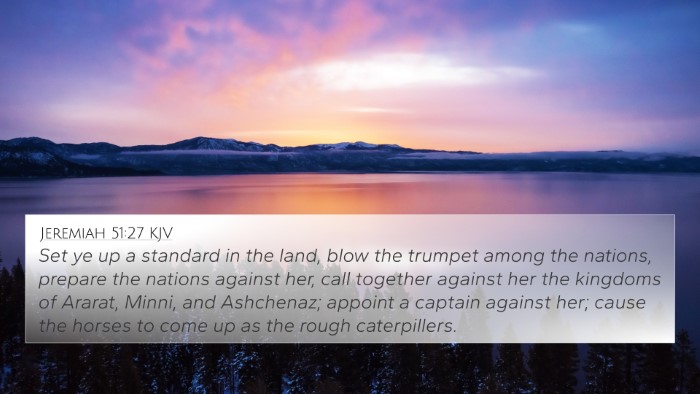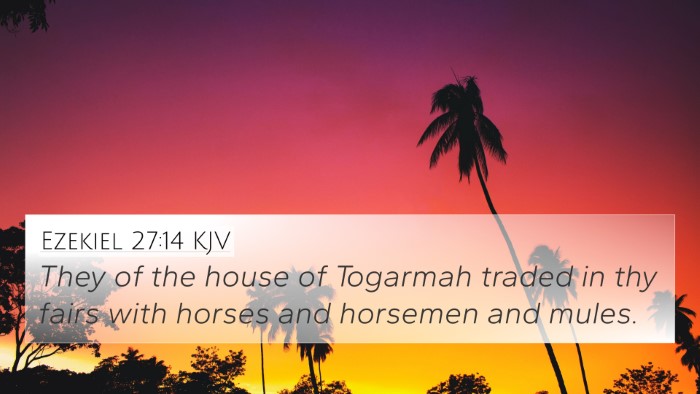Understanding Genesis 10:3
Genesis 10:3 states: "And the sons of Gomer; Ashkenaz, and Riphath, and Togarmah." This verse, while seemingly straightforward, holds significant implications when understood within its broader biblical context. Below, we summarize insights from notable public domain commentaries, providing a comprehensive understanding of this verse and its connections to other biblical texts.
Verse Context and Significance
Matthew Henry notes that Genesis 10 details the generations of Noah's sons after the flood, organizing the descendants into nations and emphasizing the fulfillment of God's command to be fruitful and multiply. This verse identifies Gomer’s sons, delineating the lineage that would contribute to the nations of the world, thus linking present nations to their origins in ancient history.
Albert Barnes reflects on the importance of genealogies in the Bible, particularly here as a record of nations. Each name represents not just individuals but entire communities and cultures that emerged over generations. The mention of Gomer’s sons lays groundwork for understanding the geographical spread of nations and peoples that would eventually influence biblical events and narratives.
Adam Clarke expands this idea by noting the etymology and historical context of the names listed—Ashkenaz, Riphath, and Togarmah. He discusses Ashkenaz as linked to an ancient people believed to inhabit parts of what is now Europe and Western Asia, and Togarmah’s historical ties to Turkey. He emphasizes these connections to show how the Bible is not only a spiritual document but also a historical one, embedding cultural narratives within its genealogy.
Bible Cross-References
This verse can be explored further through various cross-references that illuminate its themes:
- Genesis 10:2-5 - The broader context of the nations descended from Noah's sons, illustrating the dispersion of peoples.
- Jeremiah 51:27 - This verse refers to the nations that come from Gomer as part of a larger judgment prophecy, linking them to God's plans in history.
- Ezekiel 38:6 - Mentions Togarmah in the context of Gog's prophecy, showing the ongoing significance of these descendants in biblical prophecy.
- Psalm 119:90 - While not a direct connection, reflects God's faithfulness through generations, encompassing all lineages including those of Gomer.
- Isaiah 66:19 - Highlights God's desire to gather all nations, connecting modern nations back to their biblical roots.
- Romans 9:24 - Shows how God calls people from different nations, emphasizing unity through diverse origins, including Gomer’s lineage.
- Matthew 1:12 - Genealogy of Jesus relating back to these ancient lines, showing the fulfillment of God's covenant across generations.
Thematic Connections
The genealogy presented in Genesis 10 plays a crucial role in understanding the movements and relationships of biblical peoples. The list of names like Ashkenaz, Riphath, and Togarmah opens pathways for comparative Bible verse analysis:
- Identifying Connections: The genealogies link Old Testament narratives to New Testament fulfillments.
- Cross-Referenced Themes: The themes of judgment and prophecy as it relates to nations can be traced through many prophetic writings.
- Historical Context: Understanding the historical significance of these names enriches its theological implications.
- Inter-Biblical Dialogue: This verse’s connections foster dialogue between Scripture, yielding deeper insights for believers and scholars alike.
Conclusion
In summary, Genesis 10:3 serves as more than just a historical footnote; it embodies the intricate relationship between genealogies and theological narratives within the Bible. By cross-referencing other relevant biblical verses, one can trace the significant impact these names and their descendants have had in God’s unfolding plan for humanity. The insights gathered from commentaries and cross-references enrich our understanding of Scripture, allowing for a more profound engagement with the biblical text.
Further Study Suggestions
For those wishing to engage more deeply with cross-referencing and biblical study, consider the following:
- Utilize a Bible concordance to locate related verses and prominent themes.
- Explore a Bible cross-reference guide to expand your understanding of genealogies in the Bible.
- Employ cross-referencing Bible study methods for systematic bible study.
- Engage with comprehensive Bible cross-reference materials for an extensive network of biblical interconnections.
